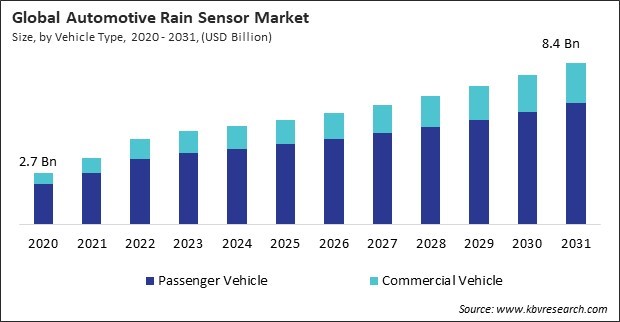“Global Automotive Rain Sensor Market to reach a market value of USD 8.4 Billion by 2031 growing at a CAGR of 7.3%”
The Global Automotive Rain Sensor Market size is expected to reach $8.4 billion by 2031, rising at a market growth of 7.3% CAGR during the forecast period.
LCVs are frequently used for commercial purposes such as deliveries, transportation services, and small-scale logistics. Drivers often operate these vehicles over extended periods and in various weather conditions. Hence, the light commercial vehicle segment would capture 62% revenue share in the market by the year 2031. Rain sensors provide convenience by automatically activating windshield wipers when precipitation is detected, allowing drivers to maintain focus on the road without manual adjustments.

DAS systems, which include features like adaptive cruise control, lane departure warning, and automatic emergency braking, rely on accurate environmental data to operate effectively. Rain sensors play a crucial role by providing real-time information about precipitation levels, enabling ADAS systems to adjust vehicle dynamics and respond accordingly. This integration enhances overall vehicle safety, reducing the risk of accidents in adverse weather conditions. Therefore, rising demand for ADAS is driving the growth of the market.
Additionally, Urban areas are often characterized by dense traffic and complex road networks, leading to a higher frequency of traffic incidents. Rain sensors are essential in these environments, as they enhance motorist visibility and responsiveness during inclement weather conditions, such as fog or rain. Likewise, traffic congestion is a common issue in urban areas, leading to stop-and-go traffic conditions that can be exacerbated by poor weather. Integrated with advanced driver assistance systems (ADAS), rain sensors enable vehicles to adjust speed and distance based on real-time weather conditions. Hence, urbanization and traffic congestion are driving the growth of the market.
However, integrating rain sensors into vehicles adds to the overall manufacturing cost, impacting consumers’ affordability. To remain attractive, automakers must balance the cost of integrating advanced technologies like rain sensors with competitive pricing strategies. Many consumers prioritize affordability when purchasing vehicles, especially in price-sensitive market segments. The high cost of rain sensors can deter some consumers from opting for vehicles equipped with this technology, particularly if they perceive the added cost as disproportionate to the perceived benefits. Thus, the high cost of rain sensors is hampering the market’s growth.
The commercial vehicle segment is further sub-dived into light commercial vehicle and heavy commercial vehicle. The heavy commercial vehicle segment attained 37% revenue share in the market in 2023. Regulatory requirements for vehicle safety and environmental standards are becoming stricter globally. Many jurisdictions mandate the use of certain safety features in commercial vehicles, including rain sensors, to improve driver visibility and reduce the risk of accidents during adverse weather conditions.
On the basis of sales channel, the market is segmented into OEM and aftermarket. The OEM segment recorded 69% revenue share in the market in 2023. OEMs integrate rain sensors directly into new vehicles during the manufacturing process. This integration ensures that rain sensors are seamlessly incorporated into the vehicle’s design and electrical systems, optimizing their performance and reliability from the outset.

Based on vehicle type, the market is divided into passenger vehicles and commercial vehicles. The commercial vehicle segment witnessed 23% revenue share in the market in 2023. The efficient operation of commercial vehicles is crucial for fleet operators to minimize downtime and maximize productivity. Rain sensors help optimize operational efficiency by ensuring drivers can focus on the road without manual distractions related to adjusting windshield wipers.
Free Valuable Insights: Global Automotive Rain Sensor Market size to reach USD 8.4 Billion by 2031
Region-wise, the market is analyzed across North America, Europe, Asia Pacific, and LAMEA. The Europe region generated 42% revenue share in the market in 2023. Europe experiences diverse weather conditions throughout the year, including frequent rain and snowfall in many regions. Automotive rain sensors are highly valued by drivers for their ability to automatically activate windshield wipers when precipitation is detected, ensuring clear visibility and safe driving conditions during inclement weather.
| Report Attribute | Details |
|---|---|
| Market size value in 2023 | USD 4.9 Billion |
| Market size forecast in 2031 | USD 8.4 Billion |
| Base Year | 2023 |
| Historical Period | 2020 to 2022 |
| Forecast Period | 2024 to 2031 |
| Revenue Growth Rate | CAGR of 7.3% from 2024 to 2031 |
| Number of Pages | 208 |
| Number of Tables | 319 |
| Report coverage | Market Trends, Revenue Estimation and Forecast, Segmentation Analysis, Regional and Country Breakdown, Porter’s 5 Forces Analysis, Company Profiling, Companies Strategic Developments, SWOT Analysis, Winning Imperatives |
| Segments covered | Vehicle Type, Sales Channel, Region |
| Country scope |
|
| Companies Included | HELLA GmbH & Co. KGaA, Hamamatsu Photonics K.K., Valeo SA, KOSTAL Automobil Elektrik GmbH & Co. KG, TOYOTA MOTOR CORPORATION, Volkswagen AG, Mercedes-Benz Group AG, BMW AG, Ford Motor Company |
By Vehicle Type
By Sales Channel
By Geography
This Market size is expected to reach $8.4 billion by 2031.
Rising Demand for Advanced Driver Assistance Systems (ADAS) are driving the Market in coming years, however, High Cost of Rain Sensors restraints the growth of the Market.
HELLA GmbH & Co. KGaA, Hamamatsu Photonics K.K., Valeo SA, KOSTAL Automobil Elektrik GmbH & Co. KG, TOYOTA MOTOR CORPORATION, Volkswagen AG, Mercedes-Benz Group AG, BMW AG, Ford Motor Company
The expected CAGR of this Market is 7.3% from 2023 to 2031.
The Passenger Vehicle segment is leading the Market by Vehicle Type in 2023; thereby, achieving a market value of $6.3 billion by 2031.
The Europe region dominated the Market by Region in 2023; thereby, achieving a market value of $3.4 billion by 2031.
Our team of dedicated experts can provide you with attractive expansion opportunities for your business.

 Drivers
Drivers
 Restraints
Restraints
 Opportunities
Opportunities
 Challenges
Challenges
